Delayed Feedback Control and Bifurcation Analysis of an Autonomy System
Abstract
An autonomy system with time-delayed feedback is studied by using the theory of functional differential equation and Hassard’s method; the conditions on which zero equilibrium exists and Hopf bifurcation occurs are given, the qualities of the Hopf bifurcation are also studied. Finally, several numerical simulations are given; which indicate that when the delay passes through certain critical values, chaotic oscillation is converted into a stable state or a stable periodic orbit.
1. Introduction
Since the first chaotic attractor was found by Lorsenz in 1963, the theory of chaos has been developing rapidly. The topics of chaos and chaotic control are growing rapidly in many different fields such as biological systems and ecological and chemical systems [1–5]. The desirability of chaos depends on the particular application. Therefore, it is important that the chaotic response of a system can be controlled.
Many researchers have proposed chaos control and synchronization schemes in recent years [6–11]; among which, delayed feedback controller (DFC) is an effective method for chaos control; it has been receiving considerable attention recently [11–14]. The basic idea of DFC is to realize a continuous control for a dynamical system by applying a feedback signal which is proportional to the difference between the dynamical variable X(t) and its delayed value [14]. Choosing the appropriate feedback strength and time delay can make the system stable. The delayed feedback control method does not require any computer analysis and can be simply implemented in various experiments. For example, Song and Wei in [15] investigated the chaos phenomena of Chen’s system using the method of delayed feedback control. Their results show that when K taking some value, taking the delay τ as the bifurcation parameter when τ passes through a certain critical value, the stability of the equilibrium will be changed from unstable to stable, chaos vanishes and a periodic solution emerges.
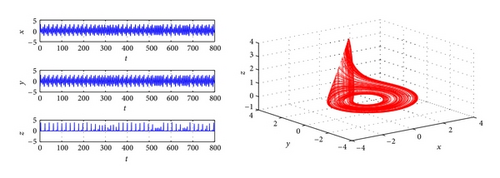
This paper is organized as follows. In Section 2, we first focus on the stability and Hopf bifurcation of the zero equilibrium of system (2). In Section 3, we derive the direction and stability of Hopf bifurcation by using normal form and central manifold theory. Finally in Section 4, an example is given for showing the effects of chaotic control.
2. Local Stability and Delay-Induced Hopf Bifurcations
In this section, by analyzing the characteristic equation of the linearized system of system (2) at the equilibriums, we investigate the stability of the equilibriums and the existence of local Hopf bifurcations occurring at the equilibriums.
Lemma 1. Consider the exponential polynomial
Lemma 2. For the polynomial equation (10), one has the following results.
Lemma 3. For the third-degree transcendental equation (5), one has the following results.
- (i)
If r ≥ 0 and ∆ = p2 − 3q ⩽ 0, then all roots with positive real parts of (5) have the same sum to those of the polynomial equation (16) for all τ ≥ 0.
- (ii)
If either r < 0 or r ≥ 0 and , and , then all roots with positive real parts of (5) have the same sum to those of the polynomial equation (16) for τ ∈ [0, τ0).
Lemma 4. Suppose that and h′(zk) ≠ 0, where h(z) is defined by (15). Then , and and h′(zk) have the same sign.
Now, we study the characteristic equation (5) of system (4). Applying Lemmas 3 and 4 to (5), we have the following theorem.
Theorem 5. Let and ω0, τ0 be defined by (14) and (15), respectively. Then consider the following.
- (i)
If r ≥ 0 and ∆ = p2 − 3q ≤ 0, then all roots with positive real parts of (5) have the same sum to those of the polynomial equation (16) for all τ ≥ 0.
- (ii)
If either r < 0 or r ≥ 0 and ∆ = p2 − 3q > 0, , and , then h(z) has at least one positive root zk, and all roots with positive real parts of (5) have the same sum to those of the polynomial equation (16) for τ ∈ [0, τ0).
- (iii)
If the conditions of (ii) are satisfied and h′(zk) ≠ 0, then system (2) exhibits Hopf bifurcation at the equilibrium E0 for .
3. Stability and Direction of Bifurcating Periodic Orbits
In the previous section, we obtain the conditions under which family periodic solutions bifurcate from the equilibrium E0 at the critical value of τ. As pointed by in Hassard et al. [17], it is interesting to determine the direction, stability, and period of these periodic solutions. Following the ideal of Hassard et al., we derive the explicit formulae for determining the properties of the Hopf bifurcation at the critical value of τ using the normal form and the center manifold theory. Throughout this section, we always assume that system (2) undergoes Hopf bifurcations at the equilibrium E0 for τ = τk, and then ±iωk is corresponding to purely imaginary roots of the characteristic equation at the equilibrium E0.
4. Numerical Simulations and Application to Control of Chaos
Conclusion 1. If K < −2.4275 or K ≥ −2.4275 and , then there exist some τ0 > 0, such that when τ ∈ [0, τ0), E0 is always unstable.
Conclusion 2. Suppose that , is defined by (63).
Thus, if we take , the stability of zero equilibrium of the system will change from unstable to stable. For this example, there are more complicated dynamical phenomena occurs. Bifurcation diagram is plotted with the parameter τ when K = −1 (Figure 2). In Figure 2, we can see that chaos vanishes via a period-doubling bifurcation when τ varying from 0 to 0.3768. Figure 3 shows that, when τ = 0.7362, a period-2 orbits bifurcating from zero equilibrium. Figure 4 shows when τ = 1.3497, a period-1 periodical orbits bifurcating from zero equilibrium. In Figure 2, a stable window is obtained from τ = 1.6243 to τ = 5.5173, which is demonstrated by Figure 5 with τ = 2.6815. When τ > 5.5173, Figure 2 shows that periodic orbits and strange attractors also occur, and system (61) through Hopf bifurcation route still goes to chaos, and it is demonstrated by Figures 6–8.
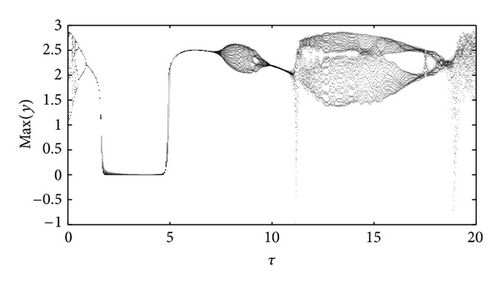
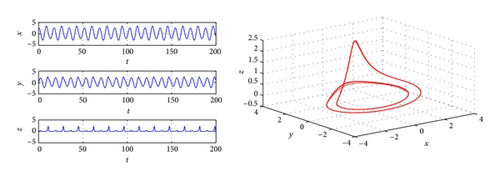
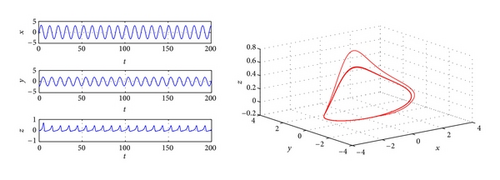
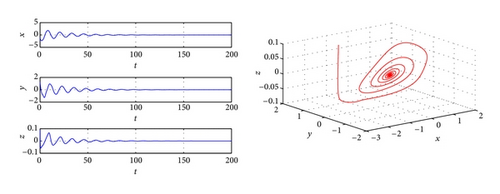

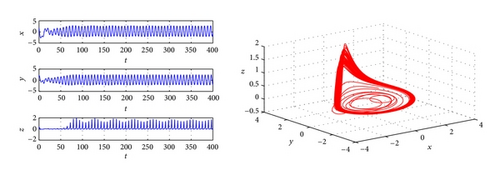
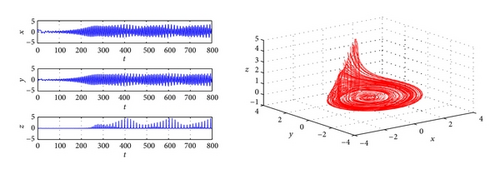
5. Discussion
In this paper, an autonomy system with time-delayed feedback is studied by using the theory of functional differential equation and Hassard’s method. Illustrating with numerical simulations, we show that delayed feedback controller (DFC) is an effective method for chaos control.
In fact, system (2) has more complicated dynamical behaves. From Figure 2, we can see that chaos degeneration process, the orbits of system (2) continuously degenerate to a periodic solution region through reverse period-doubling bifurcation. With the increasing of τ, chaos occurs again through Hopf bifurcation route. However, the numerical simulations indicate that there were points of similarity between this route to chaos and quasiperiodicity route to chaos [18]; in our future research, we will consider this topic. And in this paper, we only give detailed analysis on the trivial equilibrium E0; the detailed analysis of the interior equilibrium E* is the second interested topic in our future research.
Acknowledgments
The authors would like to thank the anonymous referee for the very helpful suggestions and comments which led to the improvement of the original paper. And this work is supported by 2013 Scientific Research Project of Beifang University of Nationalities (2013XYZ021), Institute of Information and System Computation Science of Beifang University (13xyb01), Science and Technology Department of Henan Province (122300410417), and Education Department of Henan Province (13A110108).




